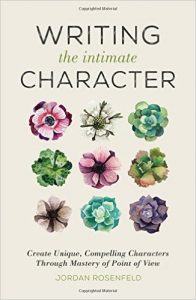Perception and How to Identify POV Leaps
By Guest | January 13, 2017 |

Photo by Andy Morffew, Flickr’s Creative Commons
Please welcome return guest Jordan Rosenfeld, author of seven books, most recently Writing the Intimate Character: Create Unique, Compelling Characters Through Mastery of Point of View (Writer’s Digest Books). Her freelance work has been widely published in The Atlantic, New York Magazine, The New York Times, Salon, Scientific American, The Washington Post, Writer’s Digest and many more.
Connect with Jordan on Twitter.
Perception and How to Identify POV Leaps
For many writers, point of view (POV) is an afterthought—an element of the craft you consider only after you’ve written a book to see if it’s working, or in frustration when it isn’t. Perhaps this is a failing of how POV has long been taught as a dry and dusty aspect of writing, considered nothing more than how you handle your pronouns, when in fact it is the foundational framework of writing strong characters, and something worthy of careful consideration in the first few drafts of your story.
POV is not only the storytelling engine, but the way you signal to the reader a character’s perception of the world around them through the senses, emotions and thoughts. It’s how you tell the reader: THIS is whose mind and heart you’re inside now. It’s also where you can learn to train your inner eye to catch POV leaps. If you’ve ever been told that you’ve made a POV error, or “leap” into another character’s head, and you’re not sure why, the answer is usually quite simple: You’ve moved from the perceptions of one character into the perceptions of another.
To break this down even further, let’s look at what I call “perceptual words”—signifiers that tell us who is having the experience, thus, whose POV we are in:
 Whenever you offer up observations, perceptions, beliefs, feelings, sensations or thoughts of any character, you have dropped into their POV (and these are just a few, mind you):
Whenever you offer up observations, perceptions, beliefs, feelings, sensations or thoughts of any character, you have dropped into their POV (and these are just a few, mind you):
- He: observed, thought, felt, saw, heard, tasted, smelled, reflected
These are mostly sensory words that refer back to what one character in a given scene can experience through his five senses.
- She: wanted, knew, understood, realized, concluded, decided, pretended, etc.
These are a different kind of perceptual experience; they include opinions and decisions, all of which are internal to a character’s experience.
If your character perceives something in a way they cannot express in physical action or dialogue alone, then you’ve entered their POV. Perception = POV.
Character Intimacy
Let’s talk for a moment about internal and external positions, which I call “intimacy.” If the information revealed to the reader comes from within a character: thoughts, observations, opinions, sensory experience, and so on—you’re internal to your character, i.e. very intimate. If information is revealed externally, it is as though you are looking at the character from the outside in: describing how they look, making judgments about them, offering information the character can’t or doesn’t know, you’re less intimate, more distant. I always recommend if you’re struggling with POV to ask: Am I inside the character looking out, or am I outside the character, looking in?
When you have opted to write in a limited, internal POV—first person, third person limited, even second person—you can only reveal to the reader the perceptions of one character per scene or chapter; ideally the protagonist, but you may have co-protagonists, and sometimes even antagonists get their own POV chapters. So if you’re hearing feedback that you’re “jumping heads” when you thought you’d chosen a limited POV, either you’ve fallen into using perceptual words for more than one character in a scene, or you’re writing in some form of omniscient.
Omniscient POV is that “all-knowing” narrator who knows more than the characters, often can project forward and backward in time, can leap in and out of multiple characters’ POVs as needed, and can offer up plot information that isn’t revealed directly through a character’s experience. There’s nothing wrong with omniscient when you’re using it on purpose, and skillfully, but many writers fall into it out of habit or lack of understanding. Many narratives don’t require the wide scope of omniscient, and a basic third person or first person, which are limited in scope, will suffice.
Omniscient is great when you need latitude—perhaps historical scope, the ability to zoom in and out of time periods; in science-fiction or fantasy where complex worlds or technology must be described; in a story with multiple non major characters, where you need to dip in and out of their heads to offer valuable information without developing an entire character arc for each one. These sorts of conditions offer themselves well to omniscient. For the rest, sticking to a limited/internal POV can actually force you to reveal only so much about the plot at a time, which is key to good tension and pacing.
Remember, strong POV is how you grant your reader access to the deepest heart and mind of your characters. And characters are the engines of great plots.
When do you consider POV? How do you use POV to get to the “deepest heart and mind” of your characters?










I recently wrote my first novel, and staying in the chosen POV was one of the more surprising challenges. It’s so tempting to jump into another character’s POV, just for a minute, rather than work to get to his intent through his actions. Thanks for this post. I am preparing to do a “final” edit, and this was a good reminder to watch for jumps in POV.
Christie,
Yes, it really is a challenge sometimes. But the more we become aware of the POV specifics, the easier that becomes.
Excellent reminder of what’s important about POV and I agree, it’s fundamental to skillful character development. If you get your POV wrong (or leave the character before you’re finished developing his or her POV), you can do irreparable damage to your character – even, in the worst case, turn him into a cardboard poster!
I would love to have your views about the omniscient approach. Could you indicate a novel where it is used in a particularly effective way? To my mind, the advantage of omniscient is that you get to tell the full story, no aspect gets dropped or forgotten. The disadvantage perhaps is that it’s hard to draw the reader in, and the risk of losing your audience is very real. Your opinion?
One author who uses omniscient POV effectively is Elizabeth George, who writes British detective fiction with a strong psychological bent. While most readers would agree Detective Lynley is her protagonist, she has a cast of very strong supporting characters whose POV’s add to the tension and intrigue.
One of her strengths is creating characters with deep psychological wounds that gradually emerge as the story unfolds. We find ourselves rooting for these characters as they make their often misguided decisions.
Her book about her writing process is called Write On and is probably available at your public library.
Elizabeth George is one of my favorite authors for exactly the reasons you listed. It is vitally important to the plot – the entire book – to focus on the main characters right out of the gate. In a recent class, I was giving an overview of POV to a group of new writers. It’s always hard to adequately portray POV to new writers; some catch the nuances immediately and others struggle. In this class, there was a struggler. No matter how many examples or explanations his fellow students or I gave him, he simply could not see anything other than first person.
Omniscient done well is remarkable. I find Anne Patchett to be a master of it. Bel Canto–her transitions are seamless. I like it in historical novels, too, that require scope. A novel called Ursula, Under, does this beautifully.
When I was writing my novel, The Sleeping Serpent, I read Anna Karenina because there were several similarities to my main character. It also happened to be in third person omniscient which I found helpful. I ended up writing in third person limited and changed POV by scene when getting into the head of the antagonist. It was challenging and required several thorough edits to catch any head hopping. I just finished reading A Little Life which does a lot of POV shifting by scene. If you read it, I would love to get your opinion. Loved the book and had to let it flow and eventually caught on…
I liked A Little Life, though I don’t recall it being in the omniscient so much as just rotating POVs from character to character in limited third person, but you might be right that it’s actually omniscient (especially in having that ability to zoom from the internal to the external). I liked the book a lot, and didn’t find the POV issue jarring.
Thanks for this post! The fashion for very close POV has relegated the perceptual tags you mention to the status of filter words. The usual advice is that they should be edited out (instead of “Toby felt his stomach sinking as he watched the boulder tumble toward him,” say “Toby’s stomach sank as the boulder tumbled toward him.”). The unfiltered form is more immediate and fun to read, but I’m unsure if every instance of filtering should be zealously trimmed. I get the idea that you, too, think there’s a purpose for these words that tend to insert a bit of distance between the character and the reader. Do you have a rule of thumb or example where filtering the POV helps the story?
I agree that you don’t have to filter every single perceptual experience into the body. There’s a time and a place for a shortcut “he felt” but I find it’s almost impossible to advise on that without reading a specific work. I think, however, when you’re exploring perceptions that are deeply tied to plot and character understanding, versus just showing us the perceptions of the weather in a scene.
“you can only reveal to the reader the perceptions of one character per scene or chapter” Not a rule I’ve ever known or followed. Most books that do follow it I think would bore me intensely. I try to unite everything a character is seeing, saying, and doing during their moment in the spotlight. I treat thought, word, and deed as events that are happening simultaneously and affecting each other. The speaker is talking, notices a change of expression on the listener’s face, and has a sudden thought, all at the same time. This cannot be done if you limit yourself to a single focus.
“Well, I used to have a girlfriend-” He noticed her eyes glaze over. ‘Crap, I’m losing her.’ He pasted on a smile. “-but that’s all over now.”
She saw his momentary look of panic and restrained a giggle. ‘Well, her stupidity is my gain.’ “So, (etc., etc.)”
I see my writing in a very cinematic way, and movies and TV shows are constantly moving back and forth between speakers. That’s what I do as I write. Whoever talks has the focus. I’m currently experimenting with trying to keep the focus on one character even when another is speaking. It feels very odd.